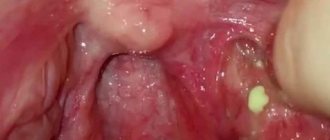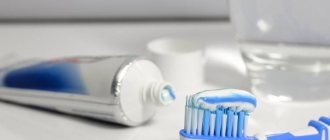White plaque on the gums can be a symptom of candidiasis, a disease caused by a fungus of the genus Candida. Under the influence of a fungal infection, stomatitis develops. First, multiple cheesy white rashes appear on the surface of the cheeks, tongue, palate and gums. Gradually they begin to grow. As the lesions grow, they merge and a film forms in the mouth.
At the beginning of the disease, plaque can be scraped off. But in the place where it was removed, small ulcers remain. When the disease is advanced, the whitish film can no longer be scraped off. The patient feels serious discomfort. Dryness, burning, pain, and a metallic taste appear in the mouth. In the advanced stage there are systemic symptoms. The head begins to hurt, the patient complains of lethargy and weakness, and the temperature rises.
Candida is an opportunistic microflora. They live in the oral cavity of any person. As long as their number is within normal limits, pathological conditions do not develop. If candida begins to multiply quickly, they provoke candidiasis.
An overview of the most common factors leading to the appearance of white plaque and stains on the gums
Normally, white plaque does not form on the gums, of course. However, with such a symptom, there is no need to immediately panic, because it can also indicate completely harmless phenomena, of which there are quite a few. First, you need to carefully examine the film formed on the mucous membrane, pay attention to the accompanying symptoms, and then draw certain conclusions.
Reasons why gums turn white
What is a white coating on a wound?
Two to three hours after extraction of the problem unit, a dark clot of blue, black or red color forms in the alveolar socket. This is a bloody secretion that forms the primary barrier to protect the socket from external elements and pathogenic bacteria. After several days, a coating appears on the surface of the clot - with a characteristic yellow, white or gray tint, externally resembling suppuration, and having a specific odor. However, this is not actually pus, but a special protein-based compound known in dentistry as fibrin.
The structure of the plaque can vary from soft to very dense. Preserving the integrity of the film allows for the development of natural processes beneath its surface:
- Gradual resorption of the blood clot:
- Reducing the diameter of the alveolar socket;
- Displacement of new cells - osteoblasts - to the central part;
- Closing the wound with regenerating gum tissue.
The formation of fibrinous plaque is a necessary process, important from the point of view of restoration of the body in the period after tooth extraction.
Sometimes plaque is just a reason to improve your oral hygiene
If you notice a white coating on your gums, especially in the morning, this may indicate a lack of good oral hygiene. Remember that a lot of bacteria live in your mouth, and if you haven’t brushed your teeth well or even skipped a mandatory daily ritual, then food remains remain there. All together leads to the formation of a microbial film, which grows especially actively at night, when very little saliva is produced in the mouth.
Typically, white plaque on the teeth near the gums, as well as on the tongue, which is detected in the morning, can be easily removed with a brush, paste, or rinse. But if you do not pay due attention to morning and evening hygiene procedures, the deposits will mineralize, that is, they will become hard. It is no longer possible to clean these at home. It is necessary to go to the dentist for professional hygiene, otherwise there is a risk of getting inflammatory processes on the mucous membrane, gingivitis, periodontitis, caries.
How is treatment carried out?
Treatment should begin with oral hygiene, and only after cleaning proceed to the main therapeutic measures. The choice of a specific treatment scenario directly depends on what specific problem the doctor will have to deal with. Obviously, if the cause of plaque is poor hygiene or teeth whitening, to get rid of the film on the gums, it is enough to rinse your mouth thoroughly - with plain water or chamomile infusion.
Chamomile infusion is great for rinsing
To treat stomatitis, I usually prescribe antiseptics and anti-inflammatory drugs, however, even in this case, much will depend on the form of the disease. If the cause of all the troubles is a fistula, then it will have to be opened surgically and the cavity cleared of purulent exudate.
On a note! Fungal infections are treated with special antifungal drugs: Nystatin, Clotrimazole, Fluconazole. Also, for a while, the patient will have to give up salty, bitter and acidic foods.
It is extremely important to start treatment for leukoplakia on time, since this disease often becomes a harbinger of oncology. In order to eliminate white plaques, an integrated approach is used - therapy is aimed at eliminating provoking factors. As part of the treatment, vitamin complexes are prescribed, and the affected areas are removed using an electric knife, laser device or radio waves. It is worth noting that liquid nitrogen is not used here because it leaves behind deep scars.
Relatively safe causes that cause a problem in an adult
As noted above, if a white coating has formed on the gum, this is not always a reason to panic. Sometimes this is a consequence of procedures such as teeth whitening, the use of rinses with an antiseptic effect, or surgical intervention in the oral cavity (for example, tooth extraction and implantation, plastic surgery).
Major appearance of white gums
True, there is a very thin line here that separates normality from pathology. After all, white formations on the mucous membrane can be both a sign of natural tissue healing (a film of white fibrin forms on them, which is called “fibrinous plaque”), and a symptom indicating the addition of an infection or the occurrence of complications. This may indicate poorly performed procedures or the patient’s violation of the recommendations given by the doctor.
Expert opinion
Elina Ruslanovna Dzagurova
Specializations: Dentist-therapist
Experience: 11+
“Mouth rinses with antiseptics should not be used for longer than 10-14 days. This can cause irritation, dry tissue, disrupt normal microflora, and lead to the development of candidiasis. As for professional and home whitening procedures, gums can also turn white due to tissue burns. But in any case, pathological conditions are not limited to just a change in the color of the mucous membrane, they are accompanied by pain, an increase in alarming symptoms, and swelling of the gums.”
The problem can be caused by an allergy to food, hygiene products, or medicinal compounds used in dentistry for dental treatment.
Important! If you have recently had your teeth whitened, used a mouthwash, or had any treatment or surgery in your mouth, monitor your condition closely. Normally, disturbing symptoms subside with each subsequent day, but with pathology they worsen, reappear, and are accompanied by a general deterioration in health, severe pain, swelling and bleeding of tissues, increased body temperature, and the formation of ulcers.
Types of stomatitis
In modern periodontology, several types of stomatitis are distinguished:
- Aphthous stomatitis. It may be accompanied by the appearance of single ulcers or multiple rashes. At the initial stage, these ulcers have a pinkish tint with pronounced red edges, but after an exacerbation, yellowish aphthae form with general swelling of the oral mucosa. Aphthous stomatitis occurs with high fever, enlarged lymph nodes, sharp pain and burning sensation while eating. There is also a chronic form that can occur in a person with a weakened immune system. In this case, this disease can manifest itself from period to period.
- Ulcerative stomatitis. It is an inflammatory disease characterized by focal destruction of the mucous membrane.
- Catarrhal - caused by poor oral hygiene, insufficient hydration of the oral cavity, the introduction of bacteria and fungi of the genus Candida. In the latter case, the disease is called candidal or fungal stomatitis, popularly known as thrush. The immediate cause of inflammation is the activity of fungi and their penetration into the mucous membrane. Candida is normally always present on the body and mucous membranes in small quantities. The disease appears when their active reproduction begins. Candidiasis is a contagious disease. It can be infected by contact, by using the same utensils and hygiene products. A characteristic manifestation of the disease is a cheesy white coating. It appears in different areas of the mucosa in the form of spots of different sizes. Associated symptoms are dryness, burning, itching. The latent period of the disease can last up to 20 days. With proper treatment, the disease resolves without complications.
- Traumatic. Injuries that cause stomatitis can be mechanical, chemical or physical and may be acute or long-term, such as improperly manufactured or installed dentures. The sharp edges of the prosthesis can irritate the mucous membranes and tongue. This provokes the appearance of stomatitis.
- Vesicular. This is one of the types of contagious stomatitis. It is caused by an RNA virus of the genus Vesiculorus of the Rhabdoviridae family. Patients should use separate hygiene products and utensils so as not to infect their household.
- Enteroviral vesicular stomatitis is caused by enteroviruses.
- Herpetic or cold sore. The disease lasts 8 days, is accompanied by weakness, drowsiness, a sharp increase in body temperature, and possible inflammation of the lymph nodes. In addition, with this type of stomatitis, gingivitis occurs and the saliva becomes viscous. The mucous membranes of the oral cavity become covered with a rash consisting of blisters that burst after three days. Accompanied by gingivitis, viscous saliva.
- Allergic. Autoimmune reactions and allergies can manifest themselves in the oral cavity. The frequency of this disease is increasing, which is associated with the emergence of new allergens and environmental deterioration. The drugs and materials used in dentistry also play a role—some people may also be allergic to them. The symptoms of allergic stomatitis in general do not differ from the manifestations of other types of inflammation of the oral cavity. Swelling, redness, pain, and the formation of various elements of a rash are observed. Ulcers and erosions may also appear. Allergic stomatitis can develop against the background of autoimmune disorders. At the same time, many variants of mucosal lesions are associated with them, when it is not possible to establish connections with other possible causes.
In addition, stomatitis can take acute and chronic forms, depending on the characteristics of its course:
- acute stomatitis is accompanied by a significant deterioration of the condition,
- Chronic is a disease that occurs periodically.
Dental problems and complications
Periodontal disease
This disease cannot be completely attributed to dental disease, since it can be provoked not only by advanced or long-term and unsuccessfully treated periodontitis, but also by internal pathologies of the body and metabolic disorders. However, the result is obvious: pale whitish gums without signs of bleeding, recession, exposure of the roots of the teeth, increased sensitivity and mobility of the dentition.
Development of periodontal disease
What is the difference between periodontitis and periodontal disease? Read here.
2. Advanced caries, pulpitis, periodontitis, periostitis
If such diseases are not treated for a long time, they are complicated by the appearance of a white spot, pimple or fistula (abscess, abscess) on the gum. This may be a sign of a cyst, granuloma, abscess, phlegmon and even osteomyelitis. Usually accompanied by severe pain. The tumor may burst, which brings relief, but this is not a reason to postpone a visit to the doctor.
Poor quality treatment
There are situations when white plaque on the gums and an abscess have formed after tooth treatment. At the same time, there is a filling or even a crown on it. In this case, the symptom may indicate poor-quality treatment, incomplete sealing of the root canals, or incorrectly manufactured and installed orthopedic construction. For example, the presence of a crown that does not correspond to the individual characteristics of the patient can lead to overload of periodontal tissues, the development of traumatic periodontitis, and, as a consequence, the formation of an abscess on the mucous membrane next to the causative tooth.
On a note! Inconvenient, poorly made, or not corrected for a long time, removable dentures often rub the gums and interfere with blood circulation in them, which leads to blue mucous membranes or the appearance of white areas on them, and can also provoke denture stomatitis.
Allergy to materials
Some patients complain that their gums become swollen and white after dental treatment. This may be a sign of the body’s individual reaction to the medications and materials used, which may also be of poor quality. This symptom is accompanied by others: the appearance of blisters and rashes, redness and itching of the mucous membrane.
5. Complications after surgery
Thus, white plaque in the gums after tooth extraction may indicate the development of an infectious and inflammatory process such as alveolitis. Pathology occurs if the socket of the removed unit is “dry”, that is, a protective blood clot does not form in it, or it is destroyed prematurely, and bacteria and food debris penetrate inside.
Complications after surgery
“I had a tooth removed for the first time in my life, and 3 days later a white coating appeared on my gums. I was very scared when I saw it. I tried to clean it carefully with a cotton swab. As it turned out later, it was in vain. I removed this film and calmed down, but a few days later severe lumbago and pain began in the area of the wound, a rotten smell came from my mouth, and pus began to ooze. I had to run to the doctor, who scolded me during the appointment. I was treated for 2 weeks. In fact, I myself became the culprit of this problem.”
Valensia, review from gidpozubam.ru
After dental implantation, during the tissue healing stage and before the sutures are removed, the gums may also be white, which is normal. But if a symptom occurs several months or even years after treatment, it may indicate the development of mucositis and peri-implantitis.
How to distinguish stomatitis from other diseases
Since stomatitis can appear for a variety of reasons, and the forms of its manifestation can be very different, it is highly not recommended to self-medicate, since in this case you can only aggravate the course of the disease and cause the appearance of new symptoms. Due to such diversity, methods of treatment and prevention of this disease can also be very different.
Manifestations of stomatitis may be similar to a number of diseases, from each of which a doctor, when examining a patient, will definitely be able to distinguish this ailment:
- Sore throat or stomatitis: you can determine a sore throat, which may be similar to stomatitis, by damage not only to the mucous membranes of the mouth, but also to the pharynx. It is very painful for the patient to swallow.
- Herpes or stomatitis: In the case of herpes, the rashes first look like blisters and appear later.
- Cancer or stomatitis: the first disease is distinguished by the fact that ulcers appear, which grow together over time. As a result, one ulcer forms and begins to grow.
- Thrush or stomatitis: when examining the mouth, if there is a disease such as candidiasis, a yellow or white coating is detected, redness, the wounds are round in shape, and the ulcers are small.
- Syphilis or stomatitis: the first disease is distinguished by the nature of the ulcers. They appear in the form of eosis and do not hurt. Sometimes there is a depression in the center of the wound.
The doctor selects the treatment for stomatitis based on the cause of the disease, the complexity of its course, the form of manifestation, the individual characteristics of the body, and so on - in general, you will have to take into account a lot of things in order to choose the correct and most effective treatment. A specialist usually easily determines that it is stomatitis and not another disease.
Common pathological conditions
Let us list in which cases white plaque in the mouth and on the gums is a sign of a serious pathology that requires prompt consultation with a doctor:
- stomatitis: can occur against the background of reduced immunity, injuries, long-term use of medications, chronic diseases. White plaque on the gums is accompanied by severe pain in the affected areas, bad breath, and a general deterioration in health. It can be candidiasis, aphthous, herpetic, vesicular, allergic, traumatic, so its independent treatment is excluded,
- Leukoplakia: this is a precancerous disease in which keratinization of the oral mucosa occurs. Factors that provoke this pathology are often smoking, malocclusion, the presence of chipped fillings and decayed teeth (they constantly injure tissue), wearing ill-fitting dentures, galvanism,
- oncology and oral cancer itself,
- pathologies of the gastrointestinal tract: for example, gastritis,
- lichen planus,
- AIDS, syphilis[1].
Plaque as a sign of tissue burn
Various thermal and chemical factors can contribute to the appearance of white plaque on the mucous membrane. For example, drinking hot drinks and soups, smoking, using aggressive compounds (manganese, hydrogen peroxide, iodine, alcohol) in the oral cavity. As a rule, after a burn, the tissues first turn red, but after a while they become covered with a whitish film, which indicates the process of their healing and renewal of the epithelium.
Photo: chemical burn of gums
Measures to help get rid of symptoms in different situations
Dynamic observation, careful care and diet correction
If white plaque appears on the gums, this does not mean that you need to immediately begin treating it. First you need to find out the reason why the symptom appeared. If it is on the surface, for example, insufficient hygiene, eating hot food and minor tissue burns, recent teeth whitening and treatment, then you need to look at the circumstances. Normally, just observation and the following actions are enough:
- treatment of the oral cavity with antiseptic solutions and herbal decoctions,
- careful daily hygiene,
- transition to a gentle diet with a predominance of soft and temperature-neutral food,
- giving up bad habits so as not to further irritate or injure tissues,
- If alarming symptoms intensify, severe pain, pus, or malaise appear, you should definitely consult a doctor.
Prosthetics and orthodontics
If the mucous membrane is injured by poorly fitting crowns and dentures, there are decayed teeth in the mouth, or an incorrect bite, you need to make an appointment with a dentist. It is important to eliminate the traumatic factor, because its constant exposure can easily provoke the same stomatitis, gingivitis, periodontitis, leukoplakia and oncology, one of the signs of which can be whitened oral tissues.
Dental treatment
If white plaque on the gums is caused by periodontitis, abscess, alveolitis and other dental diseases, then it is useless to find out what to rinse your mouth with to cure it. Antiseptics and decoctions of pharmaceutical herbs are used only in addition to the main treatment carried out by the doctor. If necessary, the specialist opens and cleans the root canals, fills and refills the teeth, removes and drains abscesses, and applies therapeutic bandages.
Gum treatment
Periodontal disease will require a long course of treatment and a whole range of measures: professional hygiene, curettage of gums, splinting of loose teeth, injections of vitamins and drugs with an effect stimulating the growth of own cells, plasma lifting, laser therapy. In advanced stages, it may be necessary to remove diseased teeth to completely get rid of the infection. Next, a thorough sanitation of the holes is carried out, one-stage implantation is immediately possible, as well as removable prosthetics.
Laser gum treatment surgery
5. Taking antihistamines and replacing dentures
If it's an allergic reaction, then you need to understand what caused it. Sometimes it is enough to simply exclude the allergen and take antihistamines for several days for any symptoms to go away. In case of allergies to prosthetic materials and galvanic syndrome, there can be only one way out - replacing the structures with those consisting of materials biocompatible with the body (ceramics, zirconium dioxide, ceramic composite).
6. Antibacterial and antifungal therapy
If you suspect stomatitis, it is better to immediately consult a dentist, who, depending on the type of pathology, may prescribe anti-inflammatory, antibacterial and antifungal agents.
What can be done for prevention
The key condition that will help avoid not only the appearance of white bacterial plaque, but also most oral diseases, is regular and proper hygiene. You should brush your teeth at least twice a day, and after meals you should rinse your mouth with plain water or a special pharmaceutical product - these are the basic principles of maintaining oral hygiene. It is also worth minimizing the risk of injury to teeth and soft tissues by external factors. To do this, try to avoid sudden temperature changes when eating. For normal functioning of the body as a whole, it is recommended to take multivitamin complexes from time to time.
Regular oral hygiene will help avoid problems
The appearance of a white film on the mucous membrane does not always indicate the presence of any problem in the body. Most often, this is just a consequence of insufficient oral hygiene. However, if after several attempts to rinse your mouth thoroughly the plaque still does not disappear, you should definitely consult a doctor.
- Anisimova, I.V. Clinic, diagnosis and treatment of diseases of the mucous membrane of the mouth and lips, 2008.











